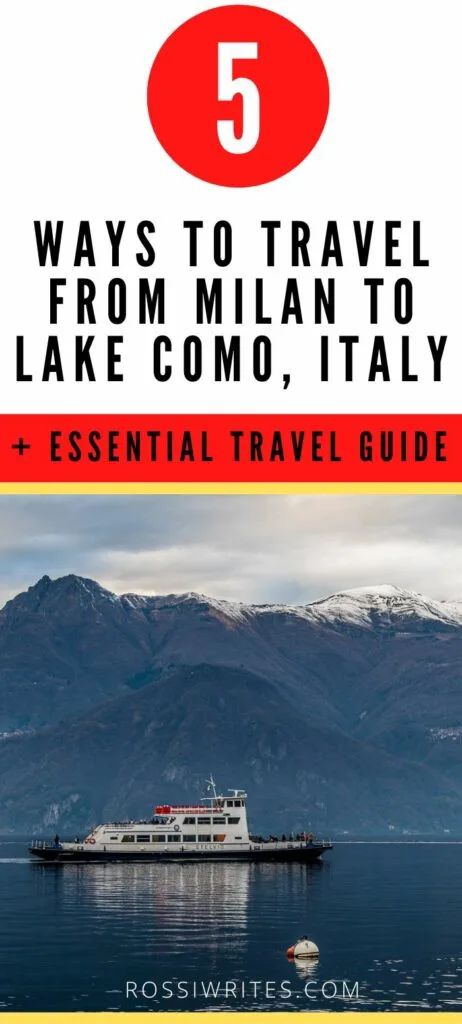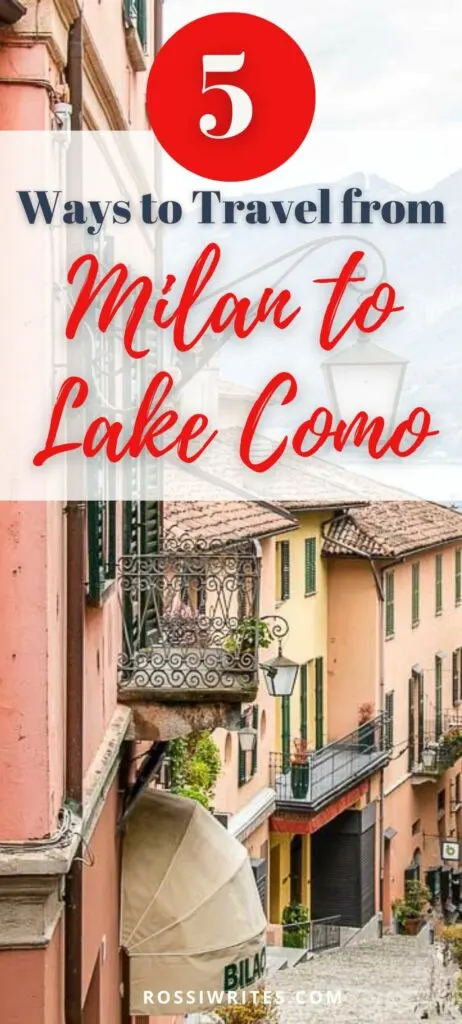Travelling from Milan to Lake Como is easy and there are five ways to do it.
Lago di Como is Italy’s most famous lake. It’s also the deepest and third-largest Italian lake. Above all, Lake Como is a great destination for a day trip, a weekend break or a longer holiday in this corner of Europe.
With shores dotted with picturesque towns, it offers a long list of exciting things to do, many historic landmarks to visit, and perfect conditions for hiking and water sports.
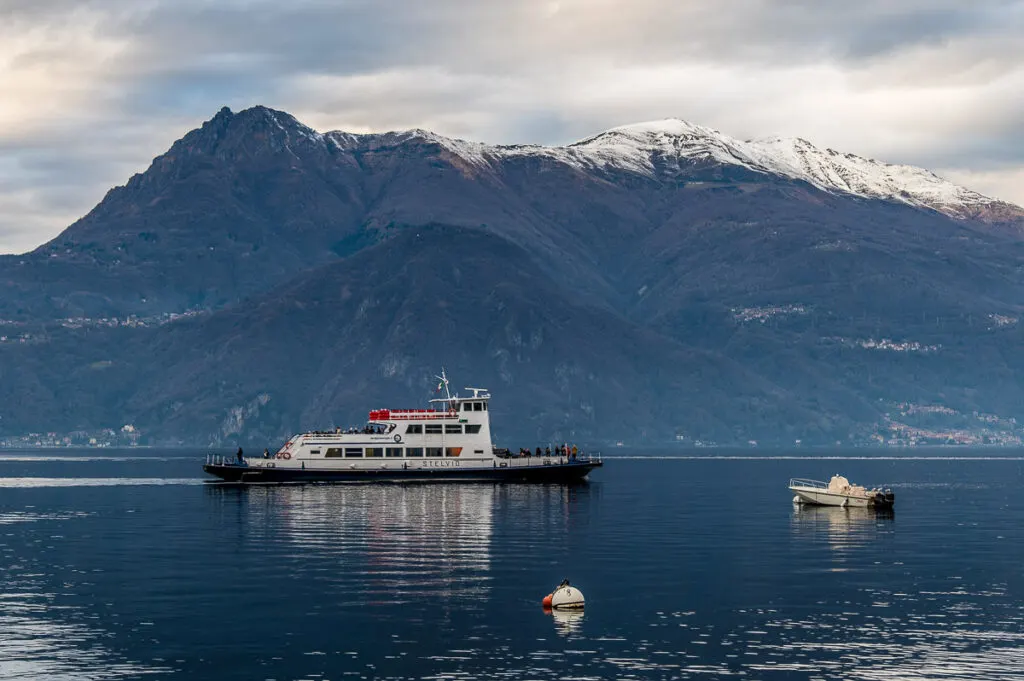
Universally known as the Fashion Capital of Italy, Milan is the country’s second-largest city. A buzzing metropolis, people flock to it on account of its monumental sights, great shopping, and impressive collection of priceless art (crowned by Leonardo’s Last Supper).
On account of its three airports and excellent road and railway connections, Milan is the most convenient large Italian city to reach Lake Como from. Several of the lakefront towns – most notably Como, Lecco, and Varenna – have railway stations. As such, travel times by train from Milan to the lake start from just under 40 minutes one way.
In addition, a fast highway, a dense network of local buses, and pedestrian and car ferries make getting from Milan to anywhere on Lake Como an easy trip to take in Italy.
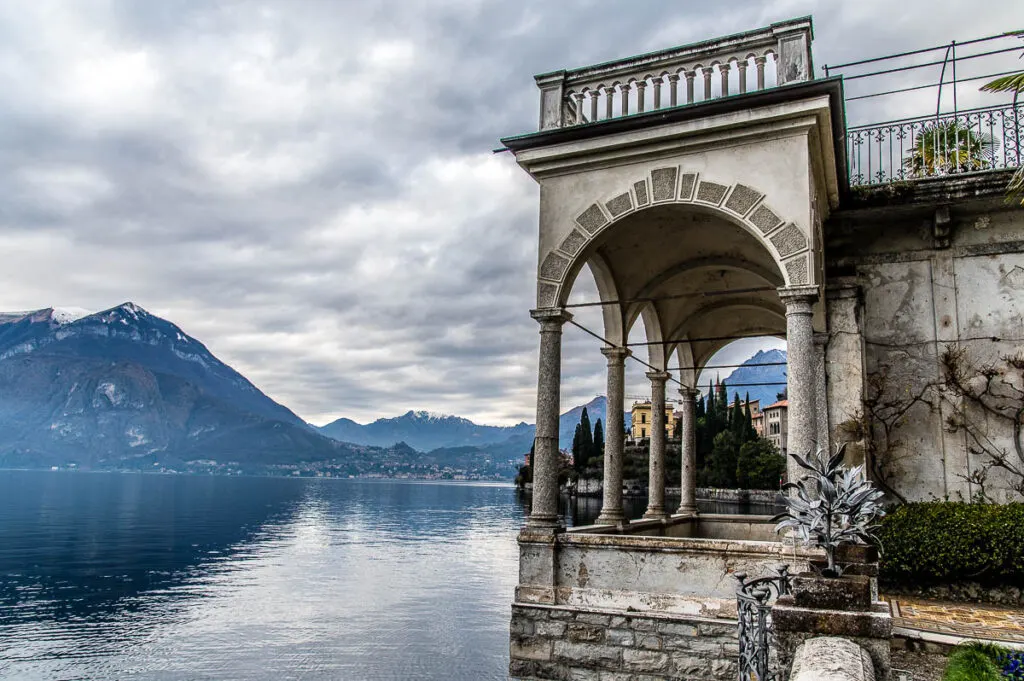
So, if you have ever asked yourself ‘How to get from Milan to Lake Como?’, fear not. In this blog post today, I will give you comprehensive and first-hand tried and tested information on reaching Italy’s most famous lake from Italy’s Fashion Capital.
It’s easy, straightforward, doesn’t have to cost the earth, and will give you a chance to see two of Italy’s most famous destinations during the same Italian holiday.
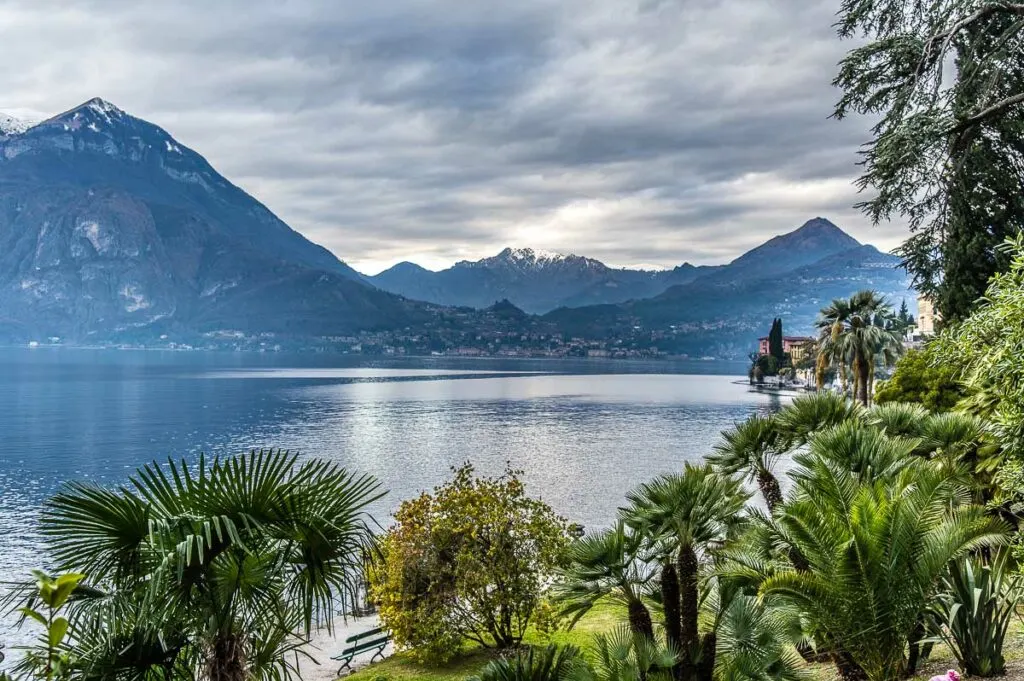
This is how we are going to proceed. First, scroll down to see a map showing the exact location in Italy of both Milan and Lake Como. Next, I will cover in detail how to travel from Milan to the different towns on Lake Como by train and by car.
Then, I will tell you about getting there by combining two different types of transport, for example, train/car and bus and train/car and ferry. I will also provide information on organised day trips to Lake Como’s most famous destinations. You can scroll up and down the page to read just the information that you need.
The second half of this blog post includes an essential travel guide for Lake Como. When to visit, how long to stay here, and what are the best things to do on its shores, everything is covered. The information is structured in a way to make your travel planning as smooth and enjoyable as possible.
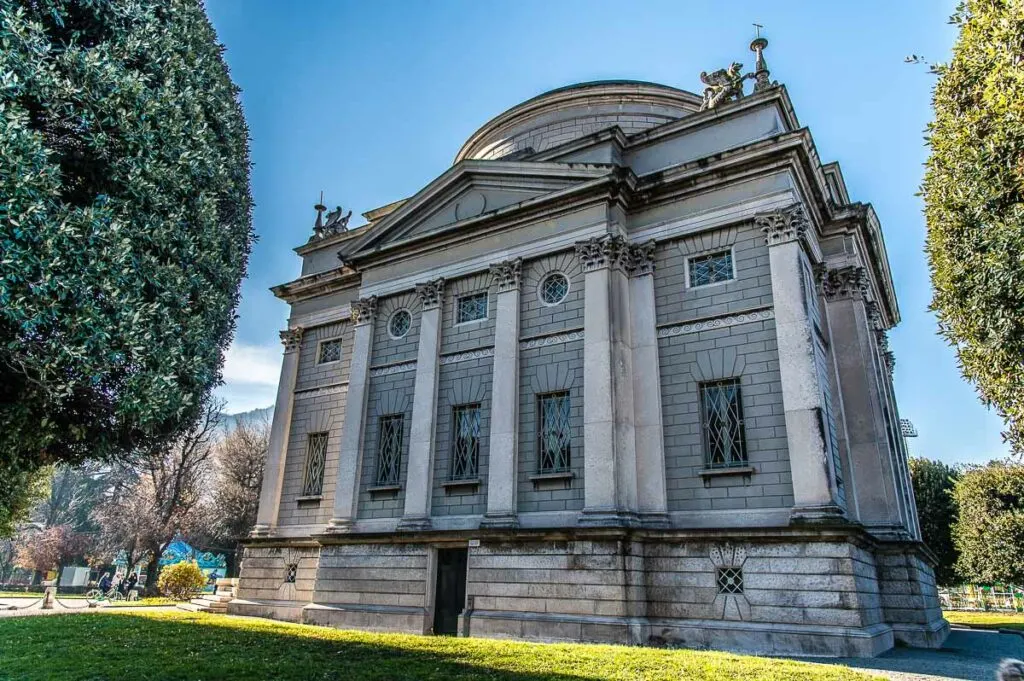
For even more details about Lake Como, have a look at these blog posts, too:
They will give you lots of ideas as to how to structure your time at Italy’s most famous lake and what to see and do here. And this blog post will tell you how to get to Lago di Como specifically from Milan.
Have a look!
Map of Milan and Lake Como in Italy
First things first! Let’s see where exactly the city of Milan and Lake Como are. Both are in Northern Italy and are part of the region of Lombardy The distance from Milan to Como and Lecco – the lake’s largest towns – is respectively 40 and 50 km.
Milan is a huge urban sprawling mass with 1.4 million people living in the city proper.
Lake Como has the unusual form of an upturned letter Y. Its three thin branches meet at Punta Spartivento. This beautiful promontory is next door to the famous town of Bellagio and affords fantastic views over the lake.
The three lake branches are named after their main lakefront towns. As such, the northern branch of Lake Como is known as Colico, the eastern as Lecco, and the western one as Como.
The mountainous area locked between the Lecco and the Como branches of the lake is called the Triangolo Lariano – the Larian Triangle (from Lake Como’s ancient name – Lario). Punta Spartivento is right at the tip of this natural triangle.
Lake Como is often affectionately called Il Uomo – or The Man – by the locals. Its outline does in fact look a bit like a man taking a large step. One of his feet rests on the town of Lecco and the other – on the town of Como.
The above map shows the exact location of the city of Milan and Lake Como in Northern Italy. Milan is pinned with a red star and the most popular/largest lakefront towns – Como, Bellagio, Varenna, Menaggio, and Lecco – with blue stars.
You can use the map just like any other map in Google Maps. You can zoom in and out, calculate directions, and open it in a new tab for easier browsing.
5 Easy Ways to Travel from Milan to Lake Como in Italy
Pin for Later!
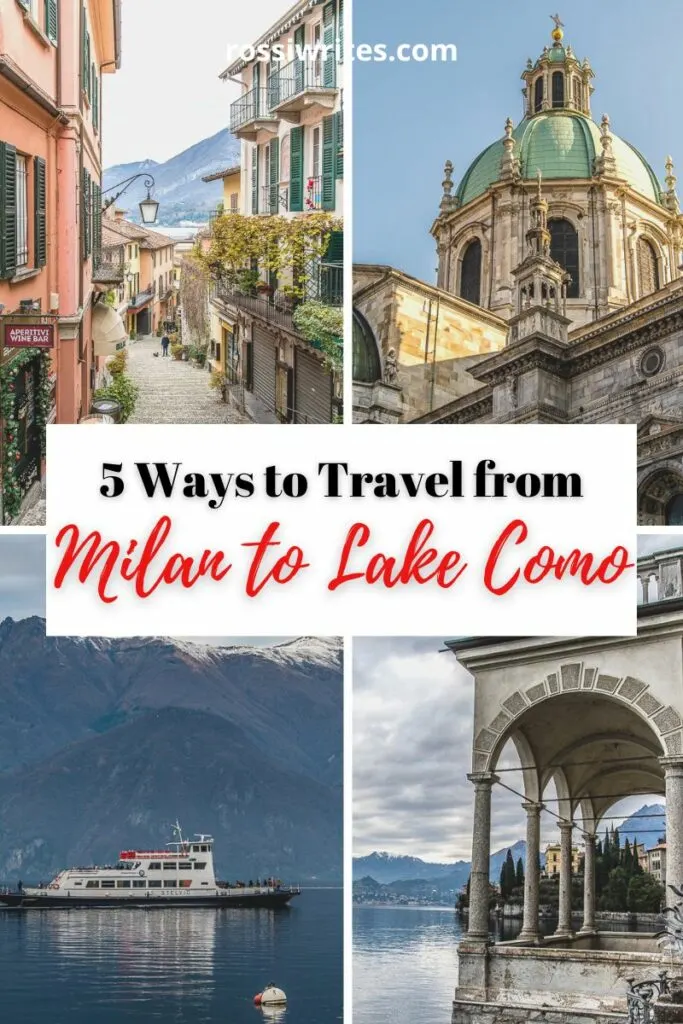

1. From Milan to Lake Como by Train

Travelling from Milan to Lake Como by train is very easy and straightforward. In many ways, this is the best way to get from Italy’s Fashion Capital to Italy’s most famous lake. Especially, if you are going to Lake Como just for the day during the high season.
Como is the only town on the Como branch of the lake with a railway link to Milan. Several towns on the eastern shore of the Lecco and the Colico branches of the lake have railway stations. This is how it works:
Railway Stations in Milan with Connections to Lake Como:
Milano Centrale – this is the city’s main railway station. It has 24 tracks, a monumental building, and deals with 120 million passengers per year. It is a very busy railway hub and often there are long queues in front of the ticket offices and the ticket-vending machines. Getting to your platform through the throngs of people can also be surprisingly time-consuming. As such, allow plenty of time to navigate the station. Travel times from Milano Centrale to the towns of Como and Lecco start from just under 40 minutes.
Milano Porta Garibaldi – this major railway station in Milan provides regular trains to Lake Como. However, they take about 20 mins longer than the trains from Milano Centrale and stop at several small towns along the way.
Milano Cadorna – this commuter railway station provides direct trains to the town of Como.
Malpensa Aeroporto T1 or T2 – these are the railway stations of Milan Malpensa Airport. Have a look at this blog post for more details on how to travel from them to Lake Como: 3 Best Airports for Lake Como.
Railway Stations in Como Town:
Como San Giovanni – this is the town’s main railway station. It stands about a kilometre away from the main landmarks here – the Duomo and the lakefront promenade. If you are arriving from either Milano Centrale or Milano Porta Garibaldi get off here and either walk or take a local bus to the historic centre.
The journey from Milano Centrale lasts around 40 minutes with three intermediate stops. The journey from Milano Porta Garibaldi is between 50 minutes and an hour with either a change in the city of Monza or 11 intermediate stops on the direct train.
Bear in mind that right before arriving at Como San Giovanni, the train is going to stop at Como Camerlata. This is a small railway station serving the southern suburbs of the town of Como. Don’t get off here. Stay on the train until you reach Como San Giovanni.
Como Nord Lago (also known as Como Lago) – this is a small, end-of-the-line railway station. It stands just off the lakefront promenade and next door to the majestic Duomo. It serves the trains arriving from Milano Cadorna and Malpensa Aeroporto T1 or T2.
The journey from Milano Cadorna lasts about an hour with 13 intermediate stops. The journey from Malpensa Aeroporto T1 or T2 is 1 hour 20 minutes with a change in the town of Saronno.
Railway Stations on the Eastern Shore of Lake Como
Getting to the eastern shore of Lake Como by train is very easy. A railway line spans its whole length from the town of Lecco in the south to the town of Colico in the north.
Starting from Milano Centrale, you can travel directly to Lecco in just under 40 minutes and then stay on the train to reach the other larger towns up the shore. Starting from Milano Porta Garibaldi, you can reach Lecco in just over an hour. If you want to travel to the other towns on the eastern shore, you will have to change trains in Monza.
As such, Milano Centrale is more convenient as a departure point. Here are some sample travel times:
- Milano Centrale to Lecco – 39 mins
- Milano Centrale to Mandello del Lario – 51 mins
- Milano Centrale to Varenna/Esino – 1 h 4 mins
- Milano Centrale to Bellano/Tartavalle Terme – 1 h 9 mins
- Milano Centrale to Colico – 1 h 26 mins
Departing from Lecco, there is also a slower local train which stops at many smaller towns and villages along Lake Como’s eastern shore.
To check train times and book train tickets in advance, I find the following three websites very useful: Omio, ItaloTreno, and TrenItalia.
Otherwise, see this handy map below showing the exact locations of the train stations you can use for Lago di Como.
Railway Stations in Milan: 1. Milano Centrale 2. Milano Porta Garibaldi 3. Milano Cadorna – with red pin
Railway Stations on Lake Como: 1. Como San Giovanni 2. Como (Nord) Lago 3. Lecco 4. Abbadia Lariana 5. Mandello del Lario 6. Olcio 7. Lierna 8. Fiumelatte 9. Varenna/Esino 10. Bellano/Tartavalle Terme 11. Dervio 12. Colico – with green pin
Other Nearby Railway Stations – 1. Malpensa Aeroporto T1 and T2 2. Saronno 3. Monza – with purple pin
Practical Travel Tips for Reaching Lake Como from Milan by Train:
Simply put, there are two types of trains you can use to reach Lake Como from Milan:
- treno regionale – this is the regional train operated by the Lombardian railway company Trenord; and
- Eurocity – this is the international cross-border train that connects Italy to its neighbouring countries.
Both the regional trains and the Eurocity trains cover the distance from Milan to Lake Como at roughly the same time, give or take a couple of minutes. At the same time, the tickets for the Eurocity trains cost on average about three times more.
As such, my suggestion is to use the regional trains for your trip to Lake Como. Their prices don’t fluctuate and you can easily buy a ticket on the day of travel thus giving you a chance to visit Italy’s most famous lake on the spur of the moment.
If you want, you can check train times in advance on Omio. This is my favourite search engine to research and book tickets for trains in Italy. It will give you a good idea of departure and arrival times
Omio pulls up a page with results from Italy’s railway companies and covers different types of trains. This way, you can immediately see who offers the cheapest prices and the shortest times and you can book your tickets on the spot. It really makes travel planning so much quicker and easier.
2. From Milan to Lake Como by Car
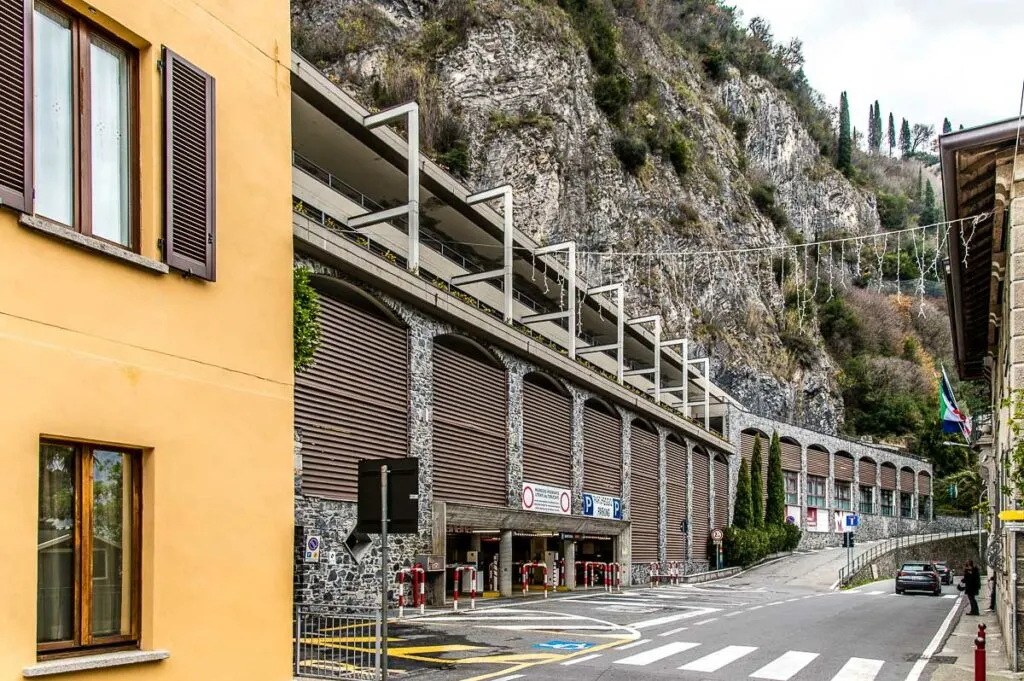
Travelling from Milan to Lago di Como by car can be both the most convenient and yet the most taxing way to explore everything that Italy’s most famous lake has to offer.
Autostrada A9 from Milan to Lake Como
Lake Como is connected to Milan by Autostrada A9. This is the oldest motorway in Italy and the world. It’s also known as the Autostrada dei Laghi (Motorway of the Lakes) and it was built in 1924. It’s a toll road. This helpful website will give you an estimate of how much the tolls are going to cost depending on the specific itinerary you want to follow.
The drive from Milan to the nearest lakefront towns – Lecco and Como – usually should take only 40-45 minutes. Expect this time to balloon by 30 minutes or more on weekends and during the high season. The outskirts of Milan are very industrial and most of the drive is not very scenic.
Lake Como’s Lakeside Road
Once you reach the lake, there is a lakeside road which skirts the whole outline of Lago di Como providing stunning panoramic views and breathtaking viewpoints. If you are the driver, however, keep your eyes on the road at all times as it is incredibly sinuous and often very narrow. There are also sharp corners, old houses angling onto the lane, and many blind spots.
The road runs through many of the lakefront towns and villages. Several of them have limited or no pavements at all. Expect to see locals and visitors strolling down the road as cars and buses pass by them. On occasion, people also go jogging along the road, so as a driver you need to be alert at all times.
Some of the local drivers – very used to the roads – drive in a very assertive manner. As such, they may encroach into the opposite lane and even try to pressure you to drive faster than you are comfortable with. If you can, don’t be too proud to let them pass and maintain a sensible speed at all times.
Highway SS36 along the Eastern Shore of Lake Como
On the plus side, however, the eastern shore of the Lecco and the Colico branches of the lake is very easy to explore by car as it’s served by the Italian highway SS36. In Italian, this fast road is known as Strada Statale 36 del Lago di Como e dello Spluga.
The road runs through a series of tunnels. From Lecco, it takes just half an hour to reach Colico (at the upper northeastern shore of Lake Como). Travel times from Lecco to Varenna and Bellano, for example, are only about 20-22 mins depending on the time of the day.
Just make sure that you keep an eye out for the right exit. If you miss it (as it happened to us once), you will need to follow the highway for quite some time before you can turn back.
Parking at Lake Como
When you explore Lake Como by car, the biggest issue you will face is finding parking. In the larger lakefront towns like Lecco and Como, there are multistorey car parks. The smaller towns here though often have very few parking spaces the majority of which are reserved for the locals. The problem is exacerbated during the high season when thousands of people travel to Lake Como on a day trip or for a longer holiday.
Distances and Travelling Times by Car from Milan to Lake Como
Here is a handy list with the distance in km and sample travelling times from Milan to some of the most popular towns on Lake Como’s three branches. The times are calculated starting from Milano Centrale train station. Your specific travel time will depend on your point of departure in Milan, the season, and the traffic conditions.
Towns on the Como Branch of Lake Como:
Milan to Como – 45 km, 45 mins to 1 h 15 mins
Milan to Bellagio – 68 km, 1 h 5 mins to 1 h 40 mins
Milan to Nesso – 70 km, 1 h 15 mins to 2 h
Milan to Cernobbio – 55 km, 45 mins to 1 h 10 mins
Milan to Lenno (for Villa del Balbianello) – 78 km, 1 h 5 mins to 1 h 40 mins
Milan to Tremezzo (for Villa Carlotta) – 80 km, 1 h 10 mins to 1h 50 mins
Towns on the Lecco Branch of Lake Como:
Milan to Lecco – 53 km, 40 mins to 1 h 15 mins
Milan to Mandello del Lario – 63 km, 50 mins to 1 h 25 mins
Milan to Malgrate – 51 km, 40 mins to 1 h 15 mins
Towns on the Colico Branch of Lake Como:
Milan to Varenna – 74 km, 1 h 5 mins to 1 h 50 mins
Milan to Bellano – 79 km, 1 h to 1h 40 mins
Milan to Menaggio – 86 km, 1 h 20 mins to 2 h
Milan to Colico – 90 km, 1 h 5 mins to 1 h 50 mins
Milan to Gravedona – 107 km, 1 h 25 mins to 2 h 10 mins
Practical Travel Tips for Reaching Lake Como from Milan by Car:
Here are a few tried and tested tips to make your car trip from Milan to Lake Como a lot less stressful and a lot more enjoyable.
If possible, opt for a small car. The smallest make possible. Space on the road around Lake Como is limited. A small vehicle will make things so much easier.
Be courteous to other drivers. Some portions of the lakeside road are so narrow and bendy that you may need to slow down or stop to let the oncoming traffic pass first.
Be mindful of pedestrians (including joggers, elderly people, and parents with strollers). Often, there are simply no pavements for them to use.
If you are staying at a local accommodation, ask if it provides parking spaces (ideally, for free). If not, it may be difficult to find a nearby place to leave your car.
Never park in a reserved parking space (usually held by the locals). Towing is active 24/7 and they are strict about it.
Parking can be pricey around Lake Como, so budget accordingly.
If you are visiting just for the day, consider parking in a multistorey car park in one of the main lakefront towns and then use the ferries or the local buses to get around.
If you see a sign with the letters ZTL on it, don’t drive beyond it. ZTL stands for Zona di Traffico Limitato in Italian or a zone with limited traffic. Such usually are the historic centres of centuries-old Italian towns and driving through one incurs a heavy fine. Bear in mind that if your accommodation is in the historic centre and provides parking spaces, it may give you a special temporary pass allowing you to drive through the ZTL. Ask in advance!
The narrow windy roads here don’t really allow high and moderate speeds. Don’t be surprised if a short journey of 15 km takes over half an hour to do. The distance from Como to Bellagio, for example, is only 30 km or so. It usually takes just under an hour and even longer during the high season.
3. From Milan to Lake Como by Train/Car and Bus
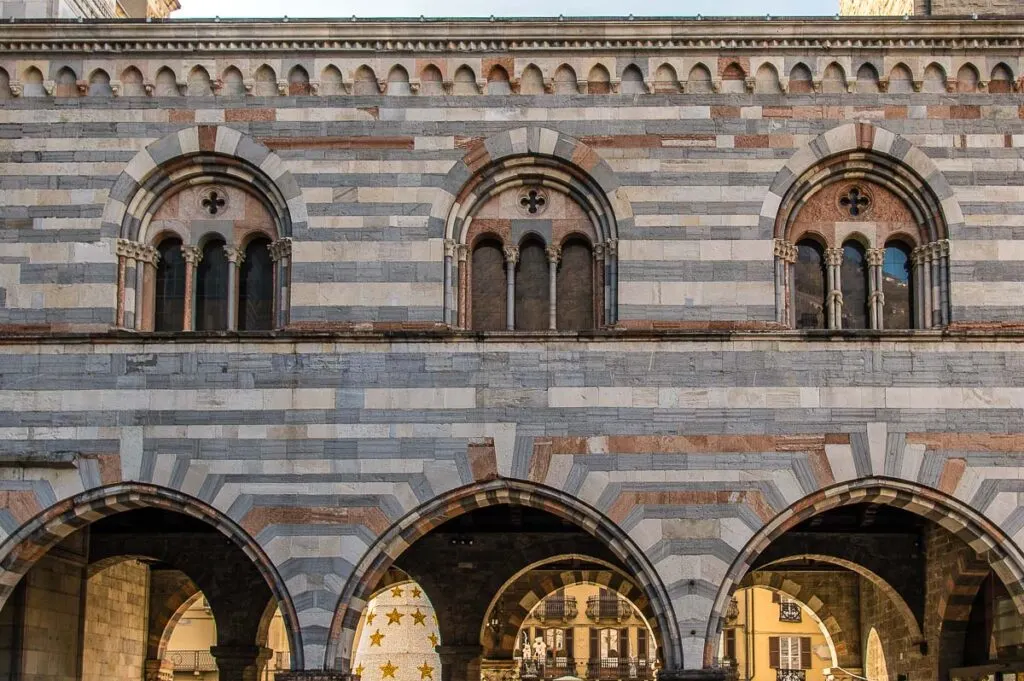
A dense network of buses connects the many towns, villages, and hamlets around Lago di Como. You may prefer to reach the lake’s major towns – Como and Lecco – by either train or car and then continue by bus onwards.
You can check the current timetables and prices for the different bus lines serving Lake Como on the website of ASF Autolinee (in Italian). You can buy a single or a return ticket to a particular destination as well as a one-day or multi-day ticket to travel around the lake. The current prices are published here. This handy map gives you a visual idea of the bus routes you can take.
In a nutshell, the main bus lines are:
C10 – taking you from the town of Como all the way up the western shore of the lake to the town of Menaggio and then along the northern end of the lake to the town of Colico. Catch it if you want to visit such iconic places as Villa del Balbianello and Villa Carlotta and explore beautiful lakefront towns such as Cernobbio, Laglio, Menaggio, and Gravedona. The bus takes around 1 h 10 mins from Como to Menaggio and it covers the full itinerary in about 2 h 15 mins or so.
C30 – taking you from the town of Como along the eastern shore of the Como branch of the lake all the way up to Bellagio. The bus stops at all the small towns and villages that dot the shore here. Nesso is particularly well known on account of Orrido di Nesso – a powerful waterfall that rumbles down a steep gorge. The journey from start to end lasts around 1 h 10 mins.
D10 – taking you from Lecco to Bellagio in about 45 mins or so. Once again, the bus stops at many lakefront towns and villages along the way and opens panoramic views over the much less visited western shore of the Lecco branch of Lake Como.
Practical Travel Tips for Reaching Lake Como from Milan by Train/Car and Bus:
Exploring Lago di Como by bus is very convenient. However, during the high season, this type of transport can get very busy, especially during the weekends and rush hours. You may need to queue to get on the bus or even need to stand up during a portion of or the whole journey. Different people may react differently when the bus arrives. Some may be pushy trying to get on board first! Be polite but stand your ground.
Another thing to be aware of is that outside of Como and Lecco the bus stops are often right on the narrow and sinuous lakeside road with not much space for a shelter or even a spot to stand. Be mindful of the passing traffic. Hold children by the hand. When you get off the bus, check to see if cars are waiting behind the bus before starting to cross the road.
You need to always check the bus timetables for Lake Como carefully. These may vary according to the season and the day of the week.
4. From Milan to Lake Como by Train/Car and Ferry
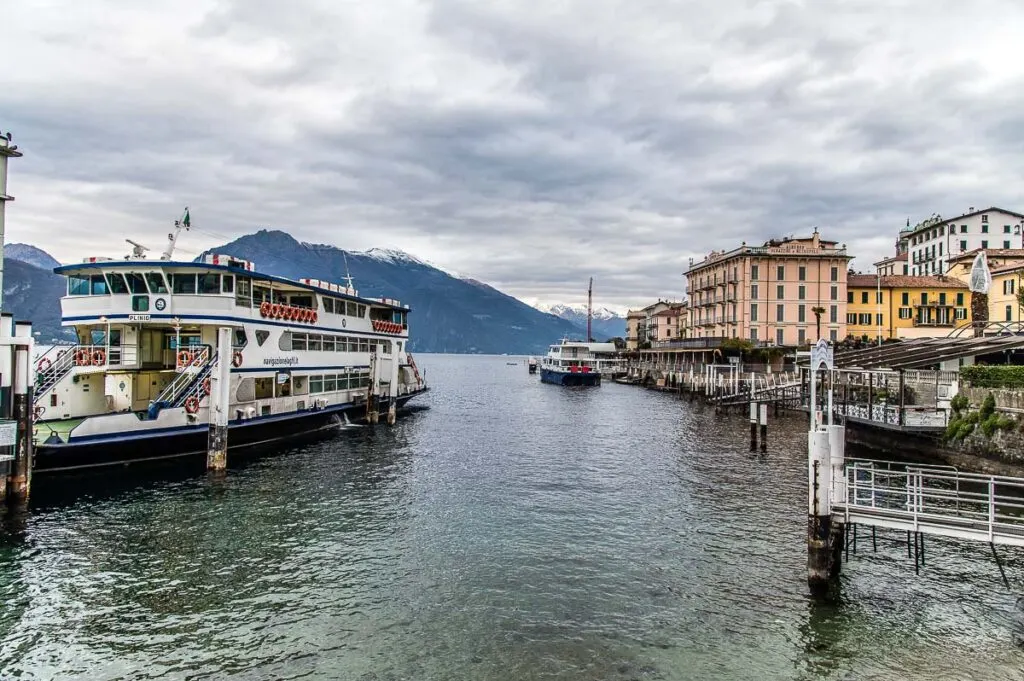
Ferries crisscross Lake Como and connect the many lakefront towns here throughout the day. Seeing the shores of Italy’s most famous lake from the water is a very scenic experience. No matter if you are spending only a day here or have multiple days to spare, make sure that you catch a ferry to fully enjoy the beauty of Lago di Como.
So, get the train or drive from Milan to either Como, Lecco, Varenna or even Colico. Then catch a ferry and cruise up or down Lake Como taking in the beautiful vistas along the way.
In a nutshell, here are the types of ferries operated by Navigazioni Laghi (the company which also runs the ferries on Italy’s largest lake – Lago di Garda):
Regular pedestrian ferries connecting the town of Como to the town of Colico – these ferries stop at many small and large lakefront towns on both sides of the Como and Colico branches of the lake. This is a slow service (for example, the journey from Como to Bellagio lasts around 1 h 30 mins to 2 h), that takes hours from start to end but provides beautiful panoramic views. In winter, the timetable of the regular ferries is heavily reduced.
Fast pedestrian ferries connecting the town of Como to the town of Colico – these ferries stop only at the most important lakefront towns on both sides of the Como and Colico branches of the lake. This is a speedy service (for example, the journey from Como to Bellagio takes around 45 mins to 1 h) and it costs more than the regular ferries.
Car/Pedestrian ferries in the central part of Lake Como – these ferries transport both vehicles and pedestrians between the towns of Varenna, Bellagio, Menaggio, and Cadenabbia. The crossing from Bellagio to Menaggio, for example, lasts only 15 mins. The crossing from Varenna to Bellagio is also only a quarter of an hour. These ferries are very convenient, open beautiful panoramic views, and most importantly, you are not stuck on them for hours. During the high season, there is also a shuttle boat for pedestrians connecting Bellagio, Tremezzina, Varena, and Bellano. This is very convenient if you want to visit some of the most famous historic sights here, for example, Villa Carlotta and Villa Monastero. The waterfall of Orrido di Bellano is also a must-see.
Pedestrian ferries connecting the town of Lecco to the town of Bellagio – These are usually operational only during the high season.
Practical Travel Tips for Reaching Lake Como from Milan by Train/Car and Ferry:
You can buy ferry tickets for Lake Como online in advance or on the day from the ticket kiosks at the ferry terminal in each town (which usually is right next to the town’s lakefront promenade).
You can purchase a one-way or a return ticket to a specific destination. Alternatively, you can opt for a one-day or a multi-day pass which gives you a chance to hop on and off the ferry to visit the many different lakefront towns along the way.
For updated ferry times, prices, and tickets, always refer to the official website of Navigazione Laghi.
Alternatively, you can book a boat tour of Lake Como. This private tour comes highly recommended. This one is much more affordable though as you get to share the boat with other visitors to the lake.
5. From Milan to Lake Como by Organised Tour
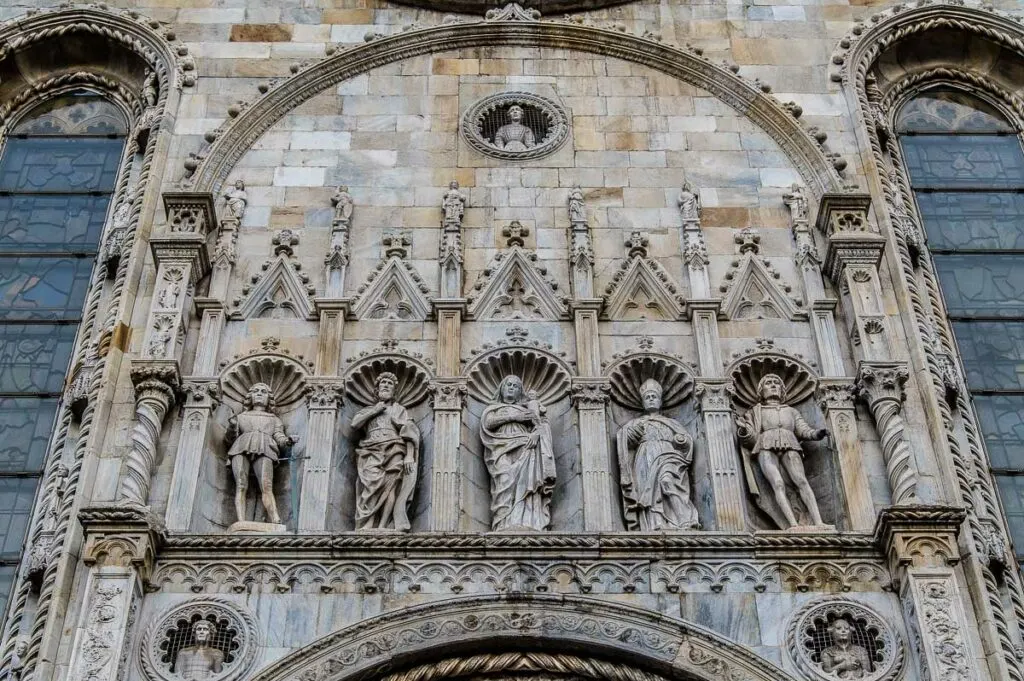
In the above sections, I gave you lots of details on how to reach Lake Como from Milan by public transport. In case you prefer to have it all organised for you, in this section I have included information about day trips to Italy’s most famous lake led by professional tour operators.
Organised tours are a great way to travel if you enjoy a more structured approach and would like to see the maximum in a short amount of time. Professional guides will introduce you to the culture and history of this corner of Italy and will show you hidden gems that are not always easy to discover by yourself.
Often, the price of an organised tour may exceed what you would pay if you booked it all by yourself. Still, it is very reasonable if you want to have it all done for you and if you enjoy a knowledgeable service and a personal approach.
As such, this guided day trip from Milan to Lake Como comes highly recommended. It takes you to several of the prettiest corners around the lake. It also combines travel by coach and boat for the best views and the maximum range of experiences.
You can also travel to the town of Como by either car or train and then join a guided trip from there. This one packs a lot of activities in a day and takes you to the two most popular lakefront towns – Bellagio and Varenna.
While you can also do it all by yourself using the tips shared in this blog post and have a wonderful time, sometimes, it pays to be shown around. Especially, if it’s your first visit to Lake Como, if you have only a short amount of time or if you find it overwhelming to find your way around in a country where you don’t speak the language.
Essential Travel Guide for Lake Como, Italy
Pin for Later!
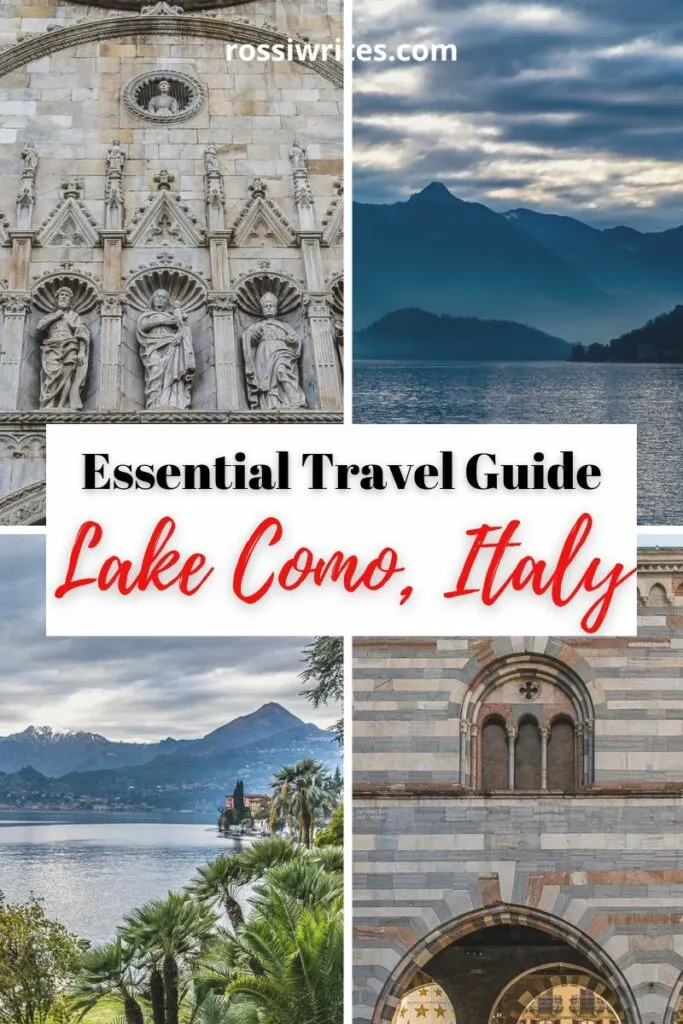
Below is an abridged version of my ultimate travel guide for Lake Como in Italy. Click here to read it in its entirety!
Is Lake Como Worth a Visit?
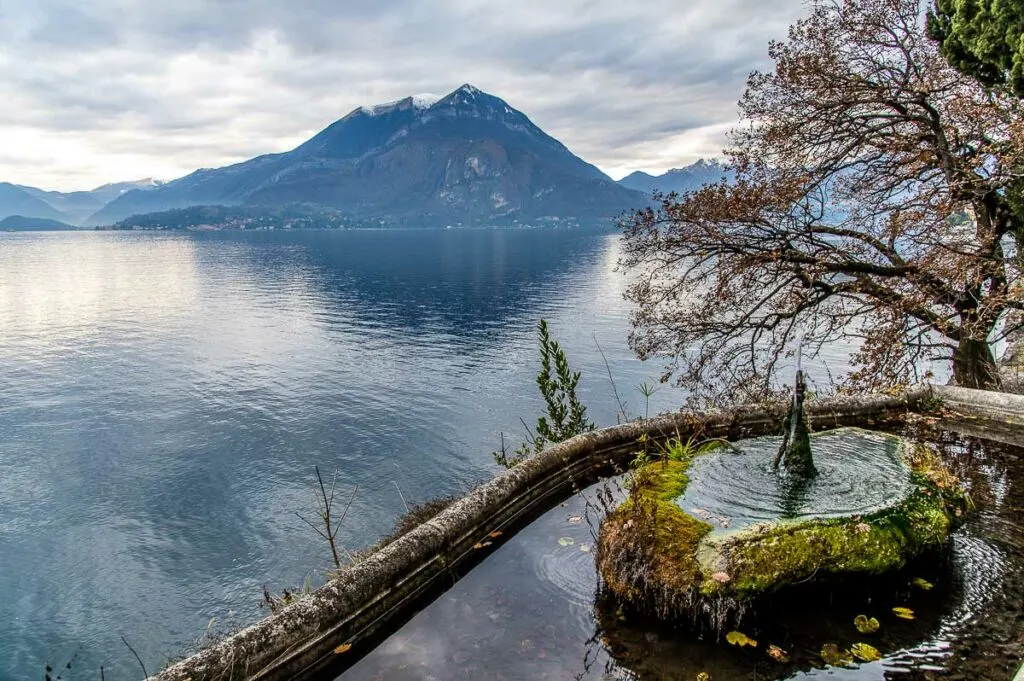
Yes, by all means, Lake Como is worth a visit when you are in Italy. With its pretty towns, historic landmarks, and beautiful natural settings, the lake lives up to the hype.
At the same time, this corner of Italy is rich in hidden gems – from ancient Roman roads and medieval hamlets to cute lidos, splendid botanical gardens, and viewpoints offering fantastic panoramic views.
The high season arrives with thousands of shrubs in bloom – from rose bushes to rhododendrons. In winter, expect festive markets, illuminations, and ice rinks. Worldwide famous, Italy’s Lake Como is one of those destinations that need to be experienced at least once.
How to Get to Lake Como from the Nearest Airports?
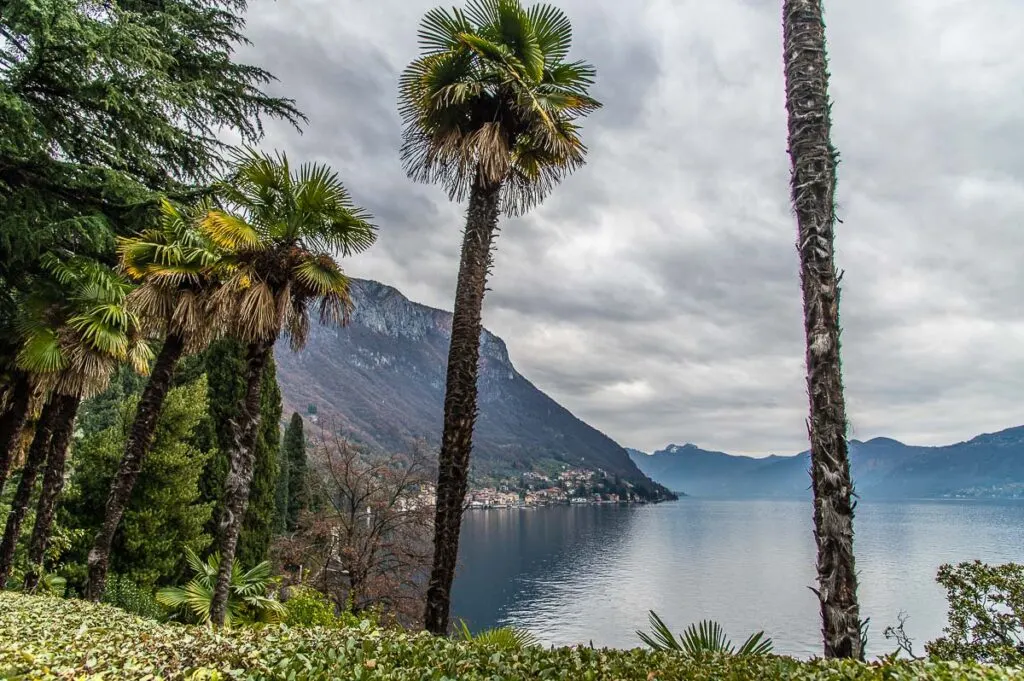
The three most convenient airports for Lago di Como are Milan Malpensa Airport, Milan Linate Airport, and Bergamo Orio al Serio Airport.
For details about how to reach the lake from them, have a look at this exhaustive blog post:
How to Get to Lake Como from Any Other Town/City in Italy or Abroad?
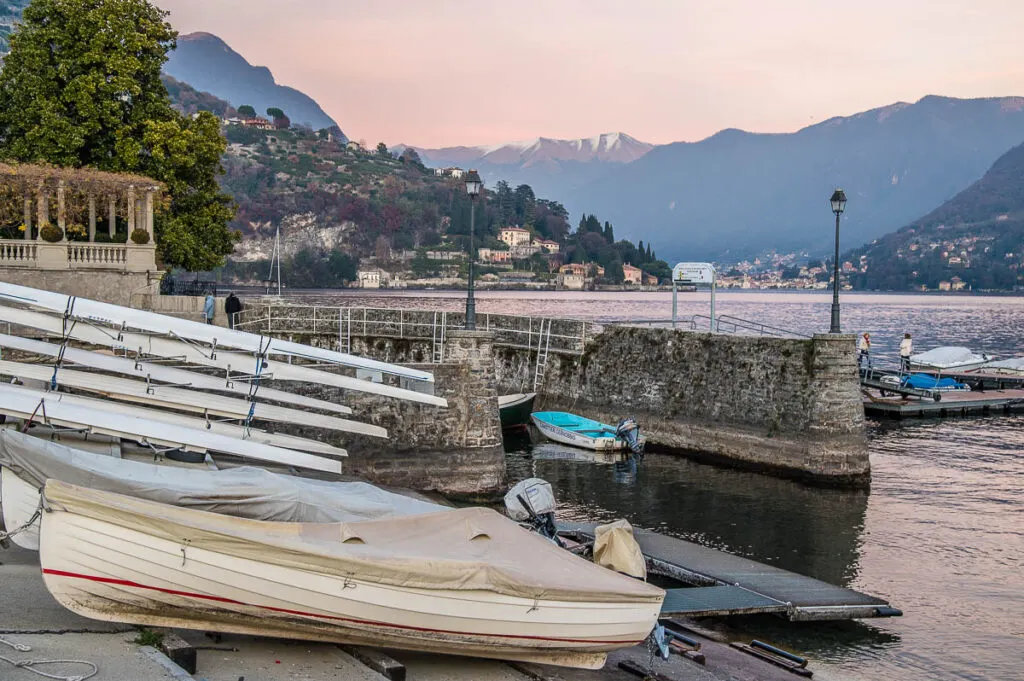
Placed in Northern Italy, Lake Como is easy to reach from anywhere in the country and abroad.
If you travel by car, you can skirt around Milan and head straight there. Just use your GPS app for directions.
If you travel by train, most probably, you will need to change trains in Milan (or nearby Monza). The three websites mentioned above – Omio, ItaloTreno, and TrenItalia – will help you get an idea about the trains to take and any changes you will need to make.
And if you travel by plane, just refer to the above point in this essential travel guide for directions from the three most convenient for Lake Como airports to the lakefront towns.
In addition, this blog post will come in very useful, no matter where you are planning to arrive from and the type of transportation you are going to use:
When Is the Best Time to Visit Lake Como in Italy?
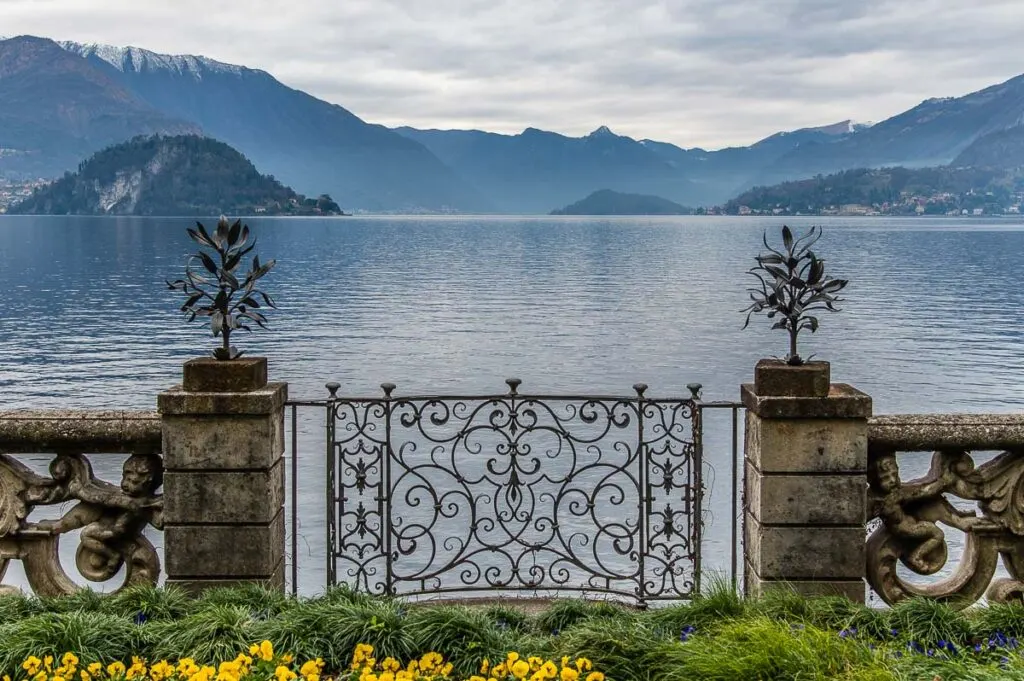
Lake Como has a lot to offer in all seasons. Summer is the busiest time of the year here. This is when hundreds of thousands of people flock to the lake to enjoy day trips and longer holidays on its shores. On summer weekends, half of Milan decamps to Lake Como, too as many of the Milanesi have villas here or simply come to hike, relax, and enjoy the stunning natural setting.
If you are planning to visit Lake Como in the summer expect large crowds of both Italians and people from all over the world. On the plus side, however, all sights – from historic villas to quirky museums – are open, lots of fun events take place, and there’s nothing like taking a cooling plunge in the water, ideally in an outdoor swimming pool floating on the lake.
In winter, the lake is very peaceful and offers great opportunities to experience its heritage and nature more authentically. While some of the historic villas and several hotels either close for the low season or operate with greatly reduced facilities, there is still plenty to do around Lake Como during the cold months. Christmas is a particular highlight with festive illuminations, markets, and events. Find out more in this blog post:
To best experience what Lake Como has to offer, try to come here during the shoulder seasons. Late March to May and then late September to October are the best periods of the year to visit. Crowds are just starting to form in spring and already dispersing in autumn. The lakefront towns are full of life. From April onwards, gorgeous rhododendrons, camellias, and roses bloom in their thousands in exquisite botanical gardens and private courtyards.
The temperatures are decidedly pleasant and vary between 15 and 20 degrees Celsius. So, you can comfortably sightsee and hike around without being scorched to a crisp by the sun. The only downside to the shoulder seasons, however, is the bigger chance of rain! April and May can have respectively up to 10 and 12 rainy days while September and October usually have around eight rainy days each. Click to find out what to do in Italy on a rainy day.
Where to Stay at Lake Como, Italy?
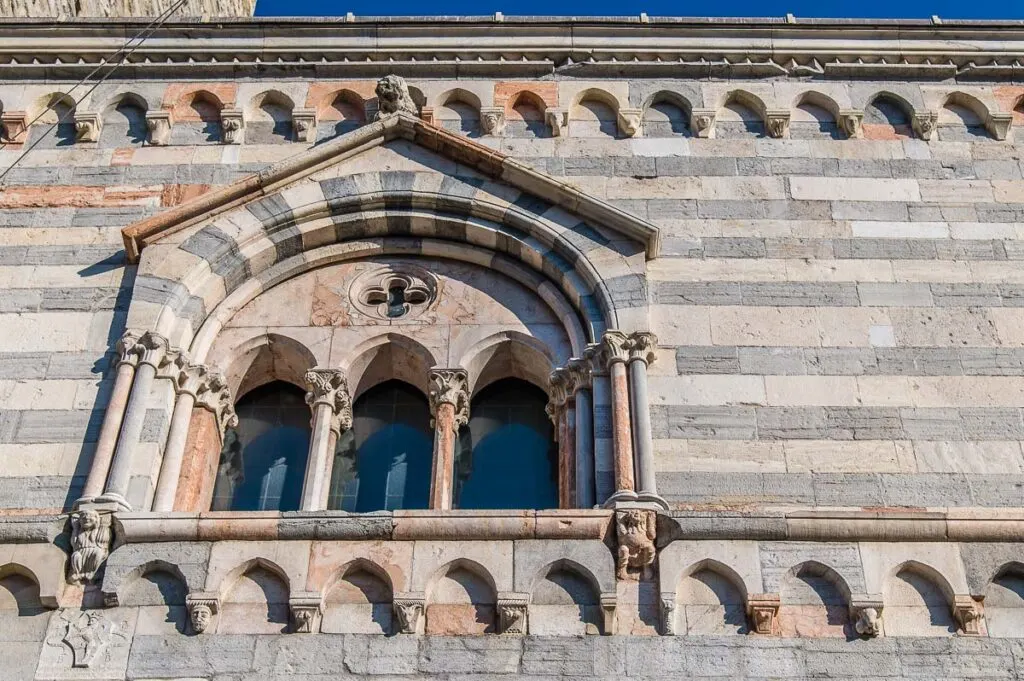
There is a huge selection of places to stay at Lake Como in any season.
You can choose from lavish historic villas that nowadays function as exclusive hotels. You can opt for a cosy B&B in the centre of a lakefront town. Or you may prefer a self-catering accommodation to enjoy a home-from-home experience.
If you are arriving by car, then make sure that your accommodation also offers parking spaces or can recommend a nearby car park. Especially, if you are planning to stay outside of the larger lakefront towns like Como and Lecco. Parking spaces in the smaller lake towns may be difficult to come across and are usually taken by the locals.
If you are relying on public transport and your accommodation doesn’t provide transfers, then make sure that you have easy access to the nearest bus stop or ferry port. You don’t want to have to walk for miles luggage in hand or depend on taxis every time you want to go to the town centre.
Here are some suggestions for places to stay at Lake Como. All come highly recommended:
Luxury: Grand Hotel Victoria concept & spa by R Collection Hotels, Grand Hotel Villa Serbelloni
Mid-Range: Casa sull’Albero, Hotel Lenno
Budget: Locanda Alberti, Valle dei Mulini – Lake Como
Alternatively, use this map to get a quick visual idea of the available accommodation options around Lake Como, Italy. You can zoom in and out, type in your specific travel dates, and then click on the different price points for detailed information about the hotel you want to know more about:
In addition, have a look at this blog post which explains the different types of accommodation you can book in Italy. It will give you plenty of ideas to look into for the best and quirkiest places to experience here:
How Long to Spend at Lake Como?

Lake Como has a lot to offer no matter your style of travel. You may be after a peaceful and relaxing holiday with stunning lake views, a pampering experience with spa procedures and some pool lounging, an active nature break with lots of hiking, or an unforgettable day trip. Or you may just want to be able to say that you’ve been to Lake Como and understand what all the fuss is about. Any reason to visit is valid!
So, how long to spend here depends entirely on you and on the amount of time you have at your disposal.
Let’s say that this will be your first visit to the lake and you just want to test the waters. Then you can easily take a self-organised or guided day trip from Milan to Lake Como and see one or a few of the most popular lakefront towns like Como, Varenna, and Bellagio. You can also book a guided day trip around the lake taking you to some of its best sights (this one comes highly recommended).
Alternatively, you can pencil in a weekend break or an even longer stay at Lake Como. It’s a big place that easily caters to all types of travellers.
What to Pack for a Visit to Lake Como?
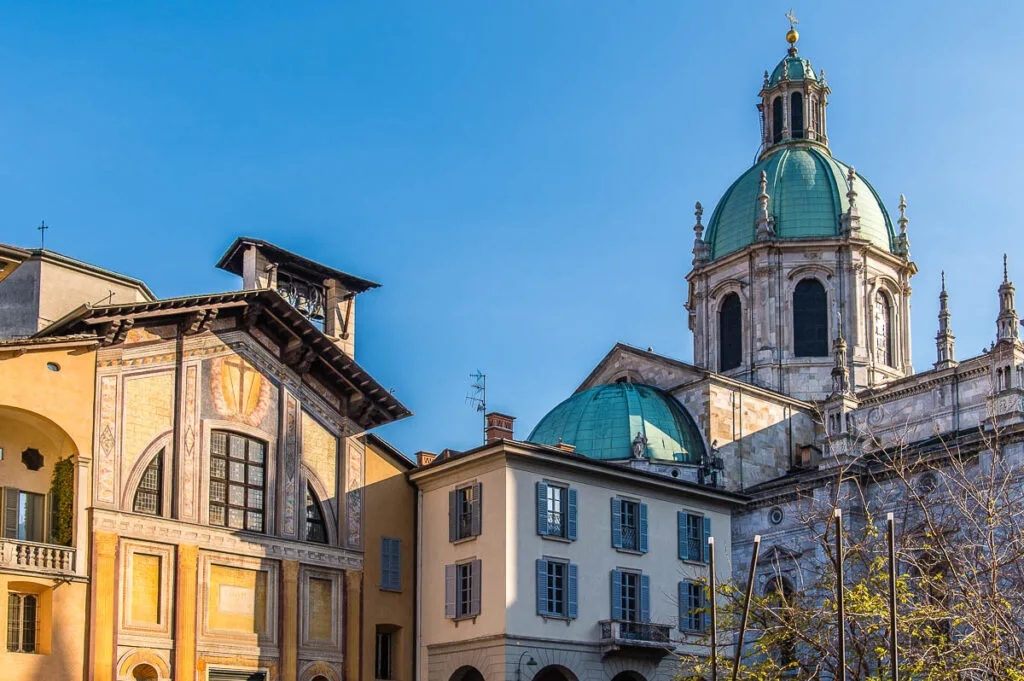
Lake Como has its own microclimate with moderate temperatures which vacillate around 26 degrees Celsius in summer and drop to around 4 to 8 degrees Celsius in winter. May and June are the wettest months in terms of rainfall and snow days in winter are very rare. Nights can get chilly in any season.
As such, no matter when you choose to visit, make sure that you pack plenty of layers. A light jacket or a cosy jersey may come in very handy during the high season. I am speaking as someone who got caught in a cold downpour in Varenna in July without a jacket because I had wanted to pack light. At the same time, don’t forget your sun cream, a hat/sunglasses, and a swimming costume.
In winter, you will want to be able to peel off a layer or two on one of those not-rare days when the sun shines bright at lunchtime and it feels like it’s spring already. At the same time, don’t forget your hat, scarf, and gloves as wrapping up warm in the evenings feels so nice.
Bringing my padded hat with ear flaps (similar to this one) was my best packing decision during my last visit to Lake Como over ten days this past Christmas. It kept me cosy during festive market explorations and hiking around.
Always pack a pair of good walking shoes for Lake Como. Plus, hiking shoes/boots are a must when you go exploring in nature. With many of the towns and villages around the lake having steep cobbled alleys and often flights of steps instead of streets altogether, your ankles need to be well supported at all times.
Unless you are planning to visit just towns like Como, Lecco, Cernobbio, and Menaggio (the central parts of which are flat), make sure that you bring an appropriate pair of shoes to allow you to safely navigate uneven surfaces and steep slopes.
What Are the Best Things to Do in Lake Como?
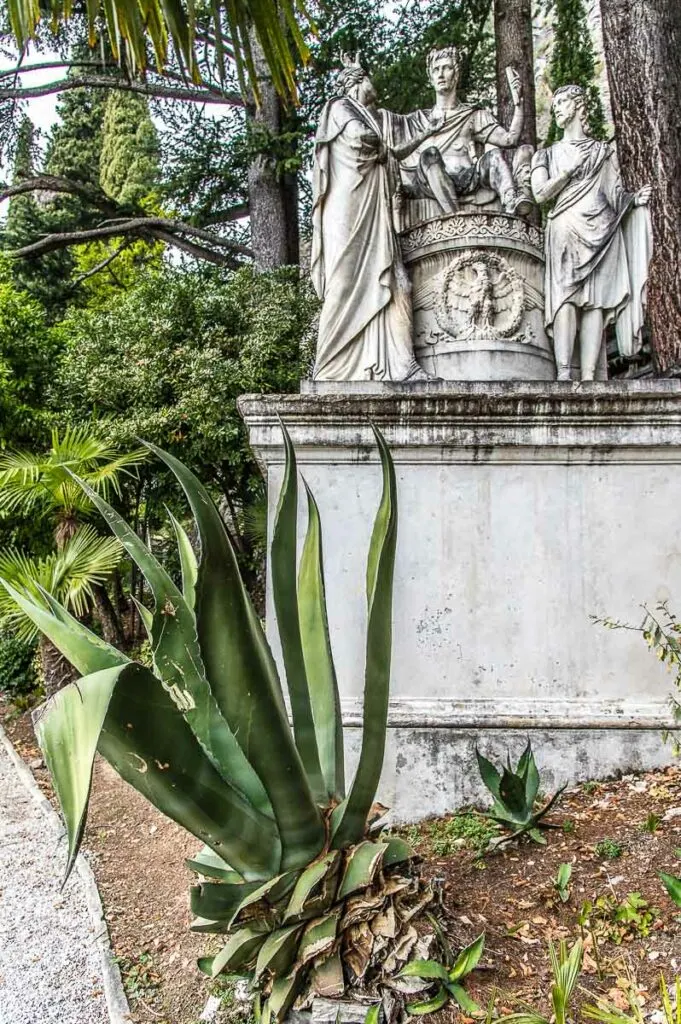
There are many amazing and exciting things to do in Lake Como. I have described them in some detail in this blog post:
Have a look at it for a useful overview of the different activities to enjoy around the lake. Otherwise, here is a handy shortlist:
Sightseeing – the shores of the lake are studded with historic villas, centuries-old churches, and excellent museums. The most well-known are the Duomo, the Volta Temple, the Civic Art Gallery, and the Silk Museum in Como, Villa del Balbianello near Lenno, Villa Monastero next door to Varenna, Villa Melzi in Bellagio, the Moto Guzzi Motorcycle Museum in Mandello del Lario, and so many others.
Hiking and Nature Exploring – it is so very easy to get close to nature around Lake Como. Hiking paths (some of which follow ancient Roman roads) crisscross the steep slopes and link the small towns and villages here. Powerful waterfalls rumble through vertiginous gorges and flow into the lake. Don’t miss Orrido di Nesso and Orrido di Bellano. You don’t even need to break a sweat to get out and about in nature here. Several funiculars and cable cars offer the chance to enjoy sprawling lake views from the comfort of a smoothly ascending cabin.
Shopping – Lake Como is a great place to indulge in some shopping no matter if you are after the latest fashions of the best Italian brands or artisan items by local craftsmen. The area is also famous for its locally designed silk accessories. Silk has been produced around the lake for centuries and nowadays you can get beautiful silk bags, scarves, and ties for yourself and your loved ones. Don’t miss the local brand Acqua del Lario which makes perfumes, candles, and home scents inspired by the towns and vistas of Lake Como.
How to Choose Which Town(s) to Visit on Lake Como in Italy?
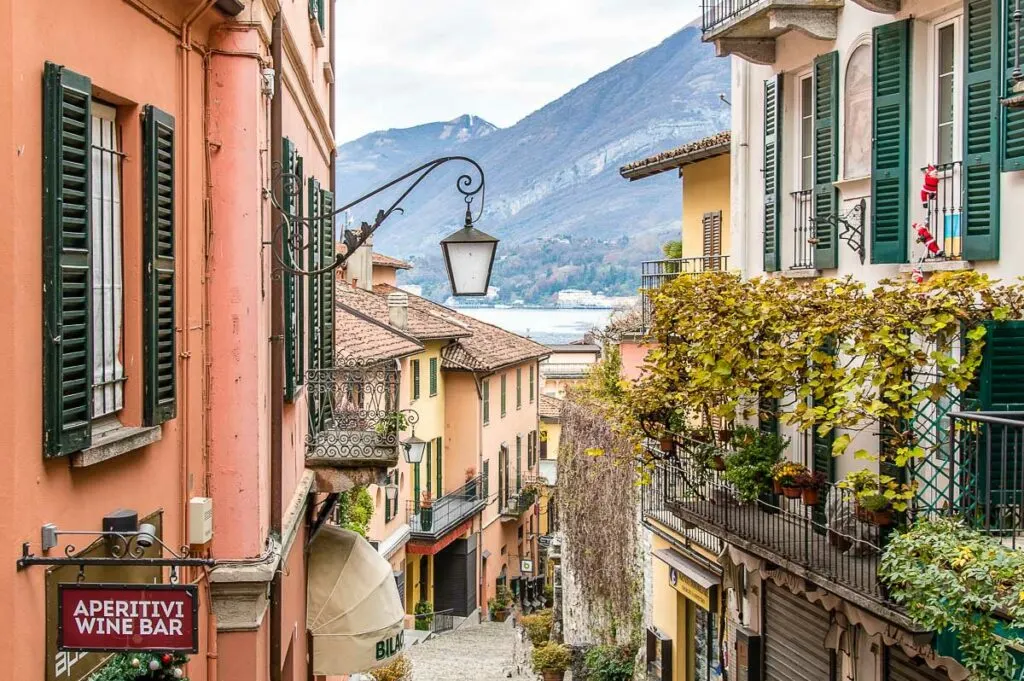
This depends entirely on you and your travel style. Ask yourself what you want to focus on – the most popular destinations around Lake Como or places off the beaten track.
The towns that attract the largest crowds (especially, during the high season) are Bellagio, Como, and Varenna. Plus, Lenno in a way on account of the nearby Villa del Balbianello. The towns of Cernobbio, Nesso, Bellano, and Menaggio are gaining popularity and have lots of hidden corners to explore.
So, make your choice based on your interests, travel style, and available time. This blog post describes the best towns on Lake Como and provides sample itineraries. They will help you narrow down the available options.
Bear in mind that many of the towns around Lake Como are built on steep slopes. They have steep alleys and stairways many of which are covered with irregular cobbles and stones. If you are looking for lakefront towns with flatter historic centres, then Como, Cernobbio, Lecco, Menaggio (and up to a point Bellagio and Bellano) can be good options.
Where to Find More Information About Lake Como and the Region of Lombardy?
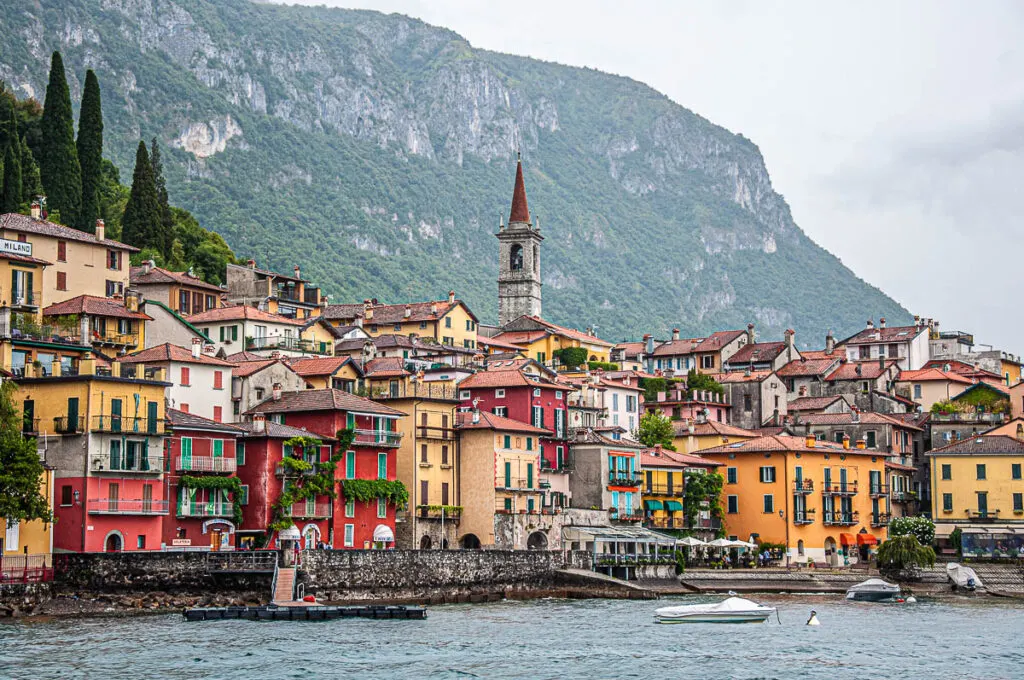
If you are considering a trip to Lake Como in particular and the Northern Italian region of Lombardy in general, you may want to also have a look at the following categories and posts on my blog:
- Lake Como – a full list of all my blog posts about Italy’s most famous lake
- Lombardy – a full list of all my blog posts about this must-see region in Italy
- Ultimate Travel Guide for Lake Como, Italy
- 25 Best Things to Do in Lake Como, Italy
- 18 Best Towns to Visit on Lago di Como – Italy’s Most Famous Lake
- Lake Como in Winter – 10 Reasons to Visit Italy’s Most Famous Lake in the Off-Season
- 10 Reasons to Visit the Region of Lombardy in Italy
- 15 Must-See Cities and Towns in Lombardy, Italy
They are based on my first-hand experience of visiting these destinations in Italy and provide lots of practical information to help you plan your travels.
In addition, for the most up-to-date information about events and local sights, keep an eye on the official websites of Milan, the Region of Lombardy, and the major towns on Lake Como, for example, Como, Bellagio, Varenna, Lecco, and so on.
Finally, if you want to invest in a good guidebook, this one covers Lombardy, Milan, and the Italian lakes. This makes it very handy to carry around with you during your travels.
Where to Find More Information About Visiting Italy?
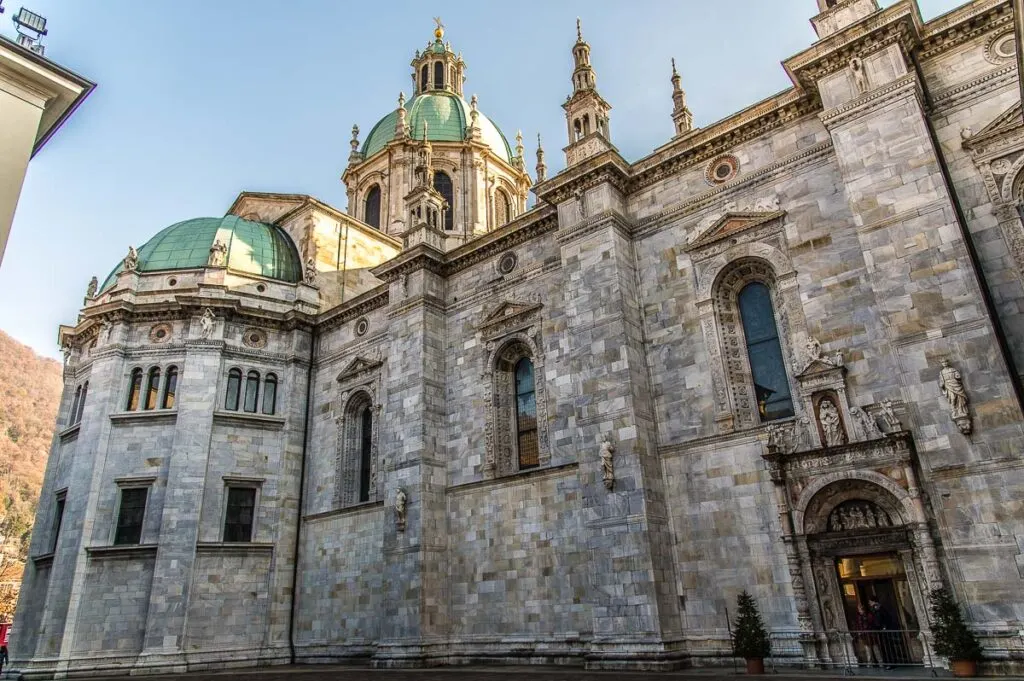
I have been blogging about travelling to and within Italy for nine years now providing detailed and first-hand tried and tested information about the best things to do in this beautiful country. It’s all based on my close to twenty years of visiting Italy solo and with my family. Six of these years, we spent living in Vicenza in the north of the country.
If you are after personally lived, meticulously researched and illustrated with dozens of original photos articles about Italy, have a look at the following categories and blog posts:
- Italy – a full list of all my blog posts about Italy
- 10 Reasons to Visit Northern Italy
- Veneto, Trentino, Emilia Romagna, Umbria – full lists of all my blog posts about these Italian regions
- Venice, Padua, Lake Garda, Milan – full lists of all my blog posts about these must-see destinations in Italy.
- Venice, Naples, Lake Garda, Lake Como – my ultimate one-page travel guides to these beautiful cities and lakes in Italy.
In addition, right at the end of this blog post, you will find a list with links to some of my most popular blog posts about many beautiful and exciting cities, towns, and regions to visit in Italy. So, just scroll down and then click on the ones you want to know more about.
Finally, Italy’s official tourism website is a great source of the latest news about travel in Italy. Otherwise, this is one of the best guidebooks about Italy.
In Conclusion

Travelling from Milan to Lake Como in Italy for a day trip, a weekend break or a longer holiday is a great idea. In general, there are five ways to do it: by train, by car, by train/car and bus, by train/car and ferry, and by organised tour.
In the above blog post, I gave you detailed and first-hand tried and tested information about how to reach Italy’s most famous lake from Italy’s Fashion Capital.
Packed with useful tips, I hope that my blog post will come in handy during the planning stages of your Italian holiday.
Enjoy your trip from Milan to Lake Como!
Travel Tools
Get Ready for Your Trip to Lake Como in Italy
Get a guidebook from Amazon.
Buy plane tickets, train tickets, and bus tickets through Omio.
Research accommodation on Booking.com.
Select local tours and activities on GetYourGuide, Viator, and Tiqets.
More Helpful Italy Info for You
Best of Italy: Italian Piazzas, Italian Markets, Accommodation for Every Budget, Best Times to Visit Italy, Italy in Summer, Italy with Kids
Italian Food: Best Italian Food Gifts, Cheap Italian Food, Rules of Italian Breakfast, Italian Breakfast Foods
Italian Coffee: Italian Coffee Culture, Italian Coffee Drinks, History of Coffee in Italy
Christmas in Italy: Fun Facts, Things to Do, Italian Nativity Scenes, Panettone, Christmas Guide
Northern Italy: Best Cities to Visit, Major Airports, Reasons to Visit
Lake Garda Towns and Villages: Best Towns, Lazise, Desenzano del Garda, Riva del Garda, Malcesine, Torri del Benaco, Punta di San Vigilio, Campo di Brenzone, Borghetto and Valeggio sul Mincio
Visiting Lake Garda: Map of Lake Garda, Getting Around Lake Garda, Lake Garda with Kids, 8 Best Airports, Venice to Lake Garda, Verona to Lake Garda, Milan to Lake Garda, Bologna to Lake Garda
Verona: Things to Do in One Day, Verona Opera Festival, Day Trips from Verona, Romeo and Juliet Itinerary, Verona to Venice, Verona to Milan
Padua: Things to Do in One Day, 101 Facts About Padua, 10 Reasons to Visit Padua, Day Trips from Padua, How to Reach Padua
Vicenza: Things to Do, Day Trips from Vicenza, Best Museums, The Beauty of Vicenza
Veneto: Top Places to Visit, Unique Adventures, Most Colourful Places, Mysterious Places, Most Beautiful Lakes, Reasons to Visit, Main Cities, Prettiest Small Towns, Most Beautiful Villages
Lombardy: Best Cities and Towns, Reasons to Visit, Brescia
Friuli Venezia Giulia: Venzone, Most Beautiful Villages
Emilia Romagna: Bologna, Ravenna, Comacchio, Most Beautiful Villages
Marche: Reasons to Visit, Gradara, Frasassi Caves, Temple of Valadier
Umbria: Reasons to Visit Perugia
Campania: Naples
Thank you for reading! Leave me a comment, pin the images or use the buttons right at the top and at the end of this blog post to share it on social media.
For more useful information like this, like my blog’s page on Facebook and Instagram and subscribe to my strictly no-spam newsletter.
Pin This Blog Post!
